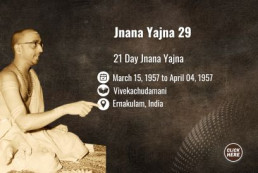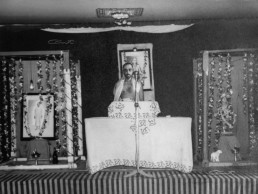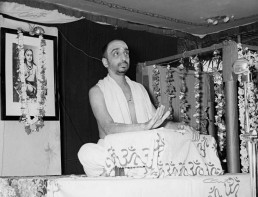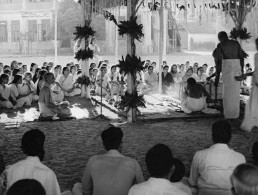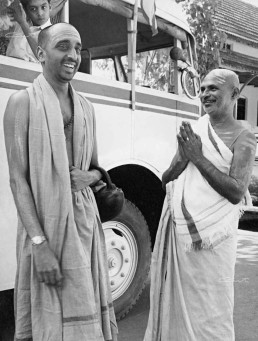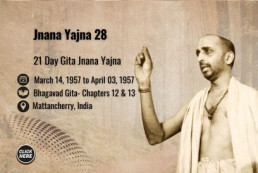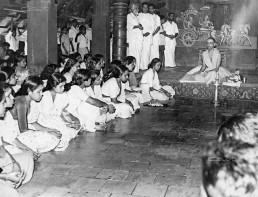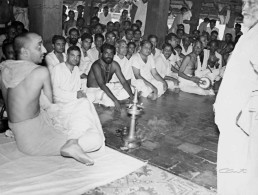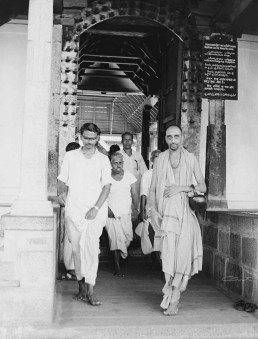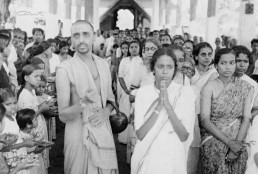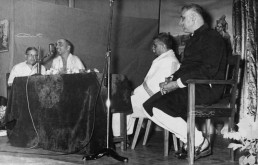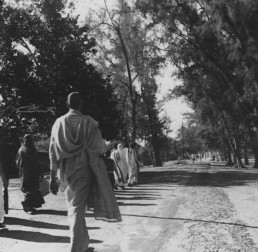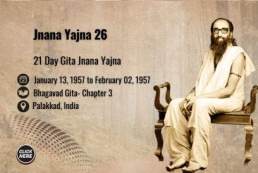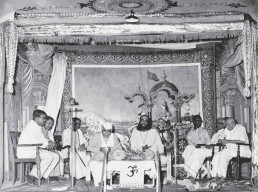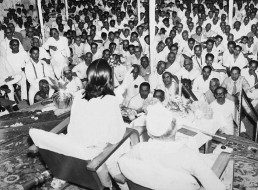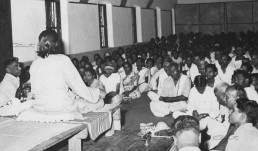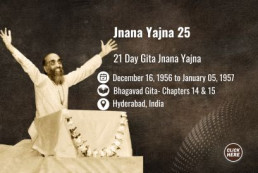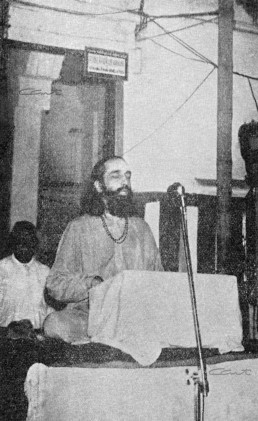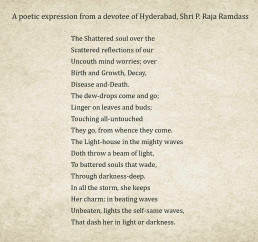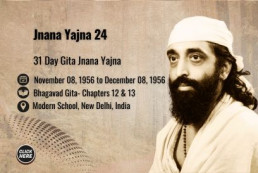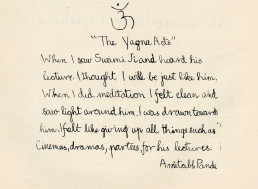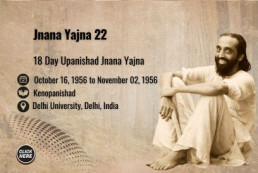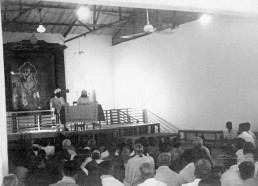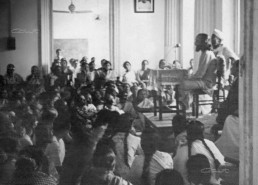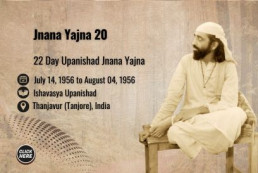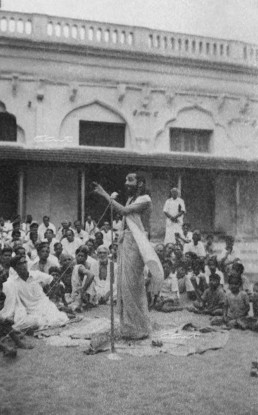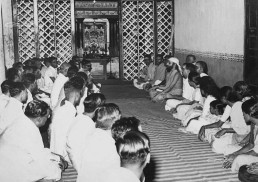Jnana Yajna 29

Jnana Yajna 29

Year & Dates:
March 15, 1957 to April 04, 1957

Yajna Topic:
Vivekachudamani

Place:
Ernakulam, India.
To a Realized Sage, the whole world is home. Still, His birthplace is significant because of the associated glory. Such is the honor of Ernakulam, the home of Balakrishna Menon who became the revered Pujya Gurudev Swami Chinmayananda. On March 15,1957, when the 29th Jnana Yajna commenced in Ernakulam, the audience was filled with joyful pride about their cherished son of the soil. That yajna on Vivekachudamani was the first yajna of Pujya Gurudev’s in Ernakulam. Adi Shankara’s crest-jewel text was going to be taught in a royal setting, on the grounds of the Ernakulam Residential Palace.
Doubly Blessed Backwaters
Excitement ran high inside and outside the splendidly decked Palace since His Highness, the Maharaja of Cochin was going to inaugurate the yajna. The meeting of Pujya Gurudev and the royal head moved and thrilled those who witnessed it; the simple and dignified Maharaja prostrated as soon as he saw Pujya Gurudev, and Pujya Gurudev too prostrated in utter humility. Their mutual love and regard for each other and for Vedanta overwhelmed everyone.
Before a beautiful portrait of Shree Adi Sankaracharya, Pujya Gurudev commenced the discourses on Vivekachudamani in that exemplary venue set amid the shimmering backwaters of the Arabian Sea on the West, the Palace on the East, and the swaying rows of coconut palm trees on the North and the South. He stressed on the importance of distinguishing between the permanent and the impermanent. He urged all seekers to transcend the hold of the body, mind, and intellect to recognize the Divine Essence within. To ensure that those who didn’t understand English could benefit from the great text, He arranged for a Malayalam translation on each day following His discourse.
An extraordinary aspect bridging the 28th and 29th Jnana Yajnas was the thoughtful cooperative effort of the two yajna committees. To enable the seekers to attend both the yajnas that were held during the same three weeks, a special motor boat was arranged to ferry them across the backwaters. From Vivekachudamani to Bhagavad Gita chapters 12 and 13, knowledge and devotion flowed seamlessly because of the generous, untiring Guru.
Photo Gallery
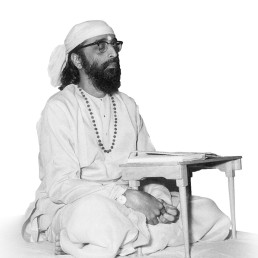
“Think,” Says Pujya Gurudev
The more we identify with the body, the more are our life’s botherations. Thus, holding onto an unreal thing becomes the essence of all bondage. This is the second definition of bondage. The first definition was in the previous verse where it was declared that considering the anatman to be the Self was bondage (v.137). Bondage is nothing other than the identification with the unreal, the perishable, the changeable, the variable, the mutable – together called the anatman, the not-Self.
From Vivekachudamani Book
What came first? Tree or Seed?
Constantly plagued by the timeless question that bewilders the human mind: which preceded the other, the tree or the seed? Is there a realm beyond this perplexity? Dive into the video to unveil the solution and contemplate the enigmatic depths of the cosmos.
Jnana Yajna 28
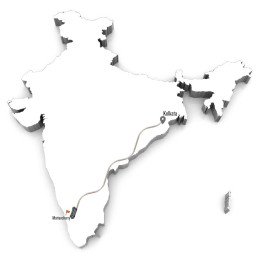
Jnana Yajna 28

Year & Dates:
March 14, 1957 to April 03, 1957

Yajna Topic:
Bhagavad Gita - Chapter 12 & 13

Place:
Mattancherry, India.
After almost two years, Mattancherry had the privilege of hosting its next Jnana Yajna. Pujya Gurudev had again chosen the right time, place, and topic for the seekers in Kerala. So, on the pleasant evening of March 14,1957, the atmosphere was jubilant inside the Diamond Jubilee Memorial Hall of the Thirumala Devaswom High School, Mattancherry. From the ancient Pazhayannur temple, the caparisoned elephant carried the pots of sacred Ganga waters, swaying to the auspicious chants of “Om Namo Narayanaya.” The Om flag fluttering in the breeze before the yajnashala seemed to reflect the joyful impatience of the yajna audience. And, one element of the inauguration was endearing and praiseworthy. A group of adorable young children trained by Smt. Janakiammal of Mattancherry Chinmaya Mission chanted the great verses of Bhagavad Gita chapter 12 in the tune that was becoming distinctly associated with Chinmaya Mission.
A Universal, Motivational Melody
Pujya Gurudev Swami Chinmayananda, reiterated that Bhagavad Gita is a “universal and perfected Science practical and applicable to one and all, under all conditions, and at all times.” He emphasized that Gita did not belong to just one religion. He noted that the magnificent portrait of the Divine Flute-Player, Bhagavan Krishna, was an apt background on the yajna stage; the Gita was an inspiring, melodic call to the entire Universe. Recommending the beauty in worship and stating how devotion elevates a devotee to selfless perfection, Pujya Gurudev motivated all to discover the Bliss of Bhakti. Explaining the knowledge embedded in chapter 13, He directed the seekers’ attention to the One Principle behind the entire field of experiences. As a special incentive to worship and know the Presence that enlivens everything, a gold medal was announced as prize for one who chanted all the verses of Gita chapters 12 & 13 in the tune special to Chinmaya Mission.
Pujya Gurudev encouraged all to realize that Shrimad Bhagavad Gita was the most enchanting and enduring prize to win in life.
Photo Gallery

“Think,” Says Pujya Gurudev
When a devotee of the Infinite Lord surrenders himself totally at His feet and acts as a messenger, or as a representative of the Will of the Lord, he becomes, not only divinely dynamic, but in and through his own activities, aware of the Presence and Grace of the Universal Spirit.
From Bhagavad Gita- Chapters 12 & 13, Book
The “knower-of-the-field” is the status of the Knowing-Principle when It is functioning in the “Field-of-the-Known.” Bereft of the field-of-objects, the “Knower” himself becomes nothing but “Pure Knowledge,” without the functions of knowing attached to it.
From Bhagavad Gita- Chapters 12 & 13, Book
What Enlivens Matter?
Understand the dynamic interplay between matter and spirit through the lens of Vedantic philosophy through this beautiful excerpt from Chapter 13 of Bhagavad Gita. Discover how Consciousness infuses life into the inert realm of matter, which alone guides us towards the experience of joy, sorrow or any of our experiences.
Jnana Yajna 27
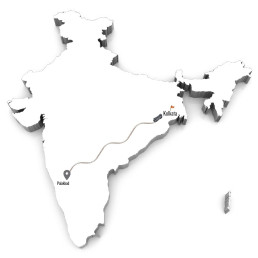
Jnana Yajna 27

Year & Dates:
February 17, 1957 to March 03, 1957

Yajna Topic:
Bhagavad Gita - Chapter 16 & 17

Place:
Kolkata, India.
Devotees who gathered at the Howrah station in Kolkata (previously Calcutta) to receive Pujya Gurudev Swami Chinmayananda were in for a surprise. The familiar “bearded, Chinmaya” emerged with a smiling, clean-shaven face, wearing no shirt but only the angavastra (draping cloth) and saffron dhoti. In respectful honor of Parama Guru Swami Tapovanam’s Mahasamadhi, Pujya Gurudev had taken the vow to be shirtless for a year. His personal austerity and Guru-Bhakti added a special glow to the spirited sage. Pujya Gurudev was, for the first time, bringing out the knowledge in Chapters 16 & 17 of Shrimad Bhagavad Gita. This notable privilege delighted the large crowds of Kolkata in the 27th Jnana Yajna.
Faith, Pure and Powerful
When Justice Ram Prosad Mukherjee unveiled the portrait of Arjuna’s despair and Bhagavan Krishna’s Celestial Song in the brimming hall of Maharashtra Niwas, it signaled a strong start to another enriching Gita Jnana Yajna. “Power is true only when supplemented by inner strength,” stressed Sri Kalidas Nag, an Indian historian and parliamentarian, in his inaugural address. With words of great power, Pujya Gurudev reminded the audience that Bhagavad Gita, the “small hand-book of instructions,” could supplement a busy marketplace with valuable virtues. He reiterated how virtues were prerequisites for entering the portals of Vedanta and that Gita did not rush to condemn the morally-fallen or commend the virtuous. The 16th chapter scientifically presented the ways an embodied self behaves in the physical, mental, and intellectual planes of experiences – disciplined or indisciplined. Then, Pujya Gurudev asserted the importance of faith in all aspects of human efforts as elucidated by Bhagavan Krishna in the 17th chapter. Pure and noble intentions fueled by deep faith can transform any venture into a spiritual victory – so taught Pujya Gurudev as His Gita Jnana Yajnas stood testimony to His unflinching faith in the Highest.
Photo Gallery

“Think,” Says Pujya Gurudev
To a seeker, living the ethical values, is in itself, a kind of treatment to cure him of some of his personality-diseases. To the Hindus, a sinner is not a dangerous mental leper or a failure of the omnipotent Lord. To a Vedantin, satan is not a perpetual challenge to God. The good, contaminated by weakness and ignorance, is the evil. And the evil, when cured of ignorance, itself becomes the good.”
From Bhagavad Gita- Chapters 16 & 17, Book
Shraddha determines the texture of our impressions in us, which in turn commands our view of life. Our desires, thoughts, and actions are charted by our view of life. Naturally, an individual’s physical activities, psychological behaviors, and intellectual makeup are all ordered by the type of Sraddha he has come to maintain in himself…As his inner disposition, so the man.
From Bhagavad Gita- Chapters 16 & 17, Book
If you have these, you are Wealthy!
In this enlightening excerpt inspired by the teachings of the Bhagavad Gita, delve into the essence of inner wealth and its significance in shaping one’s character and achievements. Explore the six essential qualities—Teja (Vigour), Kshama (Forgiveness), Dhriti (Consistency), Shaucham (Cleanliness), Adroha (Non-Cruelty), and Na-Atimanita (Humility)—that constitute the foundation of inner wealth. Discover how nurturing these qualities empowers individuals to overcome challenges, maintain resilience, and ultimately achieve success, both inwardly and outwardly.
Jnana Yajna 26
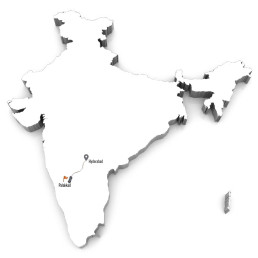
Jnana Yajna 26

Year & Dates:
January 13, 1957 to February 02, 1957

Yajna Topic:
Bhagavad Gita - Chapter 3

Place:
Palakkad, India.
The 26th Jnana Yajna of Pujya Gurudev Swami Chinmayananda in Palakkad began with zest and ended on a poignant note. On January 13, 1957, Sri Ramakrishna Rao, the Governor of Kerala, inaugurated the yajna, praising the Yajna scheme that took Vedanta to the very doors of people. Since Gita stood for the synthesis of the practical and spiritual in life, Chinmaya yajnashalas were an urgent need in the country. Introducing the theme of Bhagavad Gita, Pujya Gurudev emphasized that it showed how to build one’s spiritual stamina, face life with a smile, and spread happiness. He clarified: “ The way to apply philosophy and live it according to the context of the times is Religion.”
The Tapovana Vratam
During one of his morning satsangs on Viveka Choodamani, on January 20th, telegrams from Uttarkashi and Delhi brought the sorrowful news of Parama Guru Swami Tapovanam’s Mahasamadhi on the full moon day of January 16, 1957. On hearing that His most adored Guru had dropped the mortal frame, Pujya Gurudev closed His eyes for a few seconds in silent prostrations. Saying “More responsibility devolves on me now,” he resumed His satsang. That evening, instead of the Gita discourse, another disciple, Pandit Gopalan Nair, spoke about Swami Tapovanam, the “Glory of Himalayas.” The audience chanted Gita chapters 1 & 2 and dispersed in reverent silence.
Pujya Gurudev continued the Jnana Yajna the next day, roaring the message of the scriptures that His incomparable Guru of Uttarkashi had taught. All the regular features of the Yajna like the Akhanda Kirtan, the Havan, and even His scheduled addresses to the local colleges, schools were completed. Facing a most heart-rending loss, Pujya Gurudev epitomized His supreme love for His Guru through firm Abidance as His homage, modeling the Karma Yoga He extolled.
In Admiration
“A God without a temple, a Veda without a language…a monumental expression of an ideal Vedantic Teacher, “ wrote Pujya Gurudev in His eulogy for His venerable Guru. In His last meeting, Parama Guru Swami Tapovan said, “What is strange in Death? Death is only one of the experiences which the Atman illumines. We are not dying stuff. We are the Self.”
Pujya Gurudev reaffirmed in His tribute: “Hindu revival is the Tapovana Vratam”
Photo Gallery

“Think,” Says Pujya Gurudev
Here Krishna says that a man of Self-realization also works in the world with as much diligence and sincerely, tireless enthusiasm and enervating joy, burning hopes and scalding energy, as any ordinary man striving in the competitions of the market-place. The only difference between the two is in that, while the ignorant acts and is motivated in his actions by his “attachments and anxieties for the fruits,” a man of Godly intentions or complete Perfection will work in the world, without attachment, only for the purpose of the redemption of the world.
From Tyagi Magazine
Parents beware, Children are Watching!
In Pujya Gurudev’s inimitable manner, He gives us a 101 on Parenting by clearly highlighting how each parent is a leader for their child and the influence parents have on their children’s behavior and values. Discover how children closely observe and imitate their parents, emphasizing the importance of leading by positive example in shaping future generations.
Jnana Yajna 25

Jnana Yajna 25

Year & Dates:
December 16, 1956 to January 05, 1957

Yajna Topic:
Bhagavad Gita - Chapters 14 & 15

Place:
Hyderabad, India.
Hundred cities, 50,000 devotees, and the next stop, a silver milestone -the 25th Jnana Yajna at Hyderabad. On December 16, 1956, after a vibrant inauguration by the Andhra Pradesh Home Minister, Sri B. Gopal Reddy, and an uplifting hoisting of the Om flag by the Secretary for the 25th yajna, Rani Sarala Devi of Wanaparthy, the brimming crowd sat with alert anticipation in the Andhra Yuvati Mandali Hall, Barkatpura. Pujya Gurudev opened his yajna saying that the Gita was a handbook for the student who was eager to live with vigor and intensity, with inspiration and divinity.
Silver Milestone, Greater Journey
The handbook was available to all; so, for 21 days, Hindus, Muslims, Sikhs, Christians, and Parsees poured into the decorated hall, spilling over verandahs and nearby galleries. They listened riveted in amazement as Pujya Gurudev unfolded the fascinating varieties of life arising due to the play of Gunas; they strived to look within and around to detect the ropes of ‘mental moods’ that bind and influence the game of life. Then, Pujya Gurudev, with awe-inspiring eloquence, lifted their vision from the ever-changing to the changeless eternal substratum as indicated in the exalted Purushottama Yoga, chapter 15.
That momentous yajna where all aspects of Pujya Gurudev’s Jnana Yajna shone bright was also an important turning point in the history of Chinmaya Mission. With the guidance of Pujya Gurudev, the Constitution-making body of delegates from major branches of the Mission gathered to register and legalize Chinmaya Mission. They carefully framed the Memorandum of Association and Rules & Regulations for the sprouting branches of Chinmaya Mission. With a vision divine and a mission motivated, Pujya Gurudev’s Renaissance was in full steam. Hari Om and Hail Renaissance!
In Admiration
Rameshan of Hyderabad reflected: This, I consider to be the greatest trait of Swami Chinmayananda, viz.,that, he does not break one away from any line that one is pursuing all along, but acts as a catalytic agent, to intensify each one in his own particular line of saadhana. This is no mean achievement, inasmuch as, generally, Masters always insist that the disciple should surrender their adherence to everything else and follow their own prescribed course. But Swami Chinmayananda does not preach any particular method, but his dynamic presence is such that each one becomes stronger and abler in his own particular sadhana, and personal difficulties confronting one in his own line get clarified. He acts as a light to illuminate the paths for everyone going in different directions, and does not direct any one to any particular path.

“Think,” Says Pujya Gurudev
The term guna also means a rope, by which the spiritual beauty of life in us is tied down to the inert and insentient matter vestures. In short, gunas are the three different influences under which every human mind has to play in such an endless variety at different moments of its changing environments.
From Bhagavad Gita- Chapters 14, Book
The tree-of-multiplicity that has seemingly sprung forth from the Infinite Conscious Divine can be cut down by shifting our attention from the tree to the Divine.
From Bhagavad Gita- Chapters 15, Book
The Knowledge that transformed Narendra into Vivekananda!
Discover how the illumination of true wisdom transcends intellectual pursuits, leading to the awakening of consciousness beyond ego and worldly attachments. Witness the profound evolution of individuals into embodiments of divine truth, as exemplified by the journeys of Sri Ramakrishna and Swami Vivekananda. Experience the liberation from mental anxieties and the embrace of timeless consciousness with this enlightening discourse.
Jnana Yajna 24
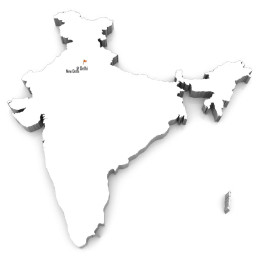
Jnana Yajna 24

Year & Dates:
November 08, 1956 to December 08, 1956

Yajna Topic:
Bhagavad Gita- Chapters 12 & 13

Place:
Modern School, New Delhi, India.
After bringing out the glorious, unifying essence of two Upanishads in two locations of Delhi, Pujya Gurudev Swami Chinmayananda retraced His steps to the place where He had conducted His very first Gita Jnana Yajna. The grounds of the Modern School on Barakhamba Road, New Delhi, which had hosted His discourses on Bhagavad Gita chapters 1 & 2 had a special glow. In the 24th yajna, the focus would be the significant chapters of 12 & 13 of Shrimad Bhagavad Gita. It was inaugurated by the then Bhaarata Raashtrapati (President of India), Dr. Rajendra Prasad.
Reshaping National Destiny
Making the audience aspire deeply for divine love, Pujya Gurudev painted the picture of an inspired devotee and his noble interaction with the world while explaining the verses of chapter 12. Moving into the exalted wisdom of the 13th chapter, He guided how to recognize “That dressed in matter is Thou.” It was a comprehensive spiritual experience of sublime devotion and precise Knowledge. To a fascinated audience, Pujya Gurudev reminded: ”Jnana Yajnas can be considered successful not because some discourses have been organized, not because those discourses have been printed in paper-books with printers’ ink. Unless the listeners get those ideas printed in the slates of their hearts with the white ink of purity, none of them can thereafter live, even for a moment, contrary to those eternal ideas of true living. Then and then only can the Yajna be considered as truly successful.”
In Admiration
Smt. Rani Bhan shares the transformation Gurudev’s talks had on her:
Swamiji’s lectures did for me what a teacher does for a willing pupil when he is faced with a problem. These lectures drew out from within me my basic urge to know and focused it on the central principle of existence. A good teacher opens up the flood-gates within one’s own Self, and through this opening, understanding gushes through, brightening up existence and ennobling life’s meaningless routines.
Photo Gallery

“Think,” Says Pujya Gurudev
Thought is the content of our subtle body. Both the mind and the intellect are nothing but thoughts. It is not sufficient if they leisurely wander around the concept of the Lord, but they have to actually penetrate, delve into, merge, and dissolve themselves away to become the very ideal of perfection which the Lord represents.
From Bhagavad Gita- Chapters 12 & 13, Book
Prakrti is matter, and Purusha is the Spirit. The Spirit in itself has no expression except when It plays through matter. When Purusha weds Prakriti, the experiences of good and bad are legions born. Electricity in itself cannot manifest a light. But when it weds with the bulb, it is manifested as light.
From Bhagavad Gita- Chapters 12 & 13, Book
Don’t get attached to your body!
Immerse yourself in Pujya Gurudev Swami Chinmayananda’s enlightening video on dispassion and detachment from sense objects and the misconception of body identification. Gain insights into the pursuit of genuine happiness beyond temporary pleasures and the shedding mental burdens.
Jnana Yajna 23
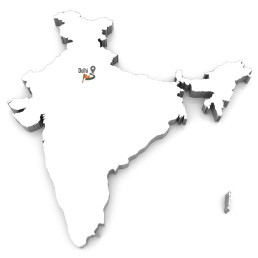
Jnana Yajna 23

Year & Dates:
October 16, 1956 to November 02, 1956

Yajna Topic:
Mundakopanishad

Place:
Kashmere Gate, Delhi, India.
Under a shaded Ashvattha tree in the historic atmosphere of Kashmere Gate in old Delhi, the yajna on Mundakopanishad commenced on the full moon evening of October 16, 1956. Pujya Gurudev Swami Chinmayananda had completed the inaugural two-hour discourse of Kenopanishad to the students of Delhi University earlier that evening. Without a minute wasted, He proceeded to the Kashmere Gate venue to begin His next Upanishad Jnana Yajna on Mundakopanishad. It was a unique experiment – conducting two Jnana Yajnas on two different Upanishads at two locations concurrently! The Delhi audience was ready to make the most of this dual blessing.
Tireless Teaching, Twice and More
In her welcome address, Srimathi Rani Bhan, the Secretary of the yajna, said, “Shri Swamiji is no individual personality but an emblem of India’s determination to awake. He is to all of us the symbol of the Hindu Revival. He is to us the voice of the rishis of yore.” Pujya Gurudev became the voice of Sage Angirasa who answers an eminently successful householder, Sounaka’s transcendental question about the Highest Knowledge. As Pujya Gurudev unraveled most systematically the contents of the most sublime Mundakopanishad, the audience were fascinated. His incredible clarity of expression made the sincere seekers attempt to bring the Ungraspable, Attributeless Eternal Self within intellectual focus. His eloquence and experience made all contemplate on lofty topics such as Creation, Consciousness, and Brahman.
A most compassionate Teacher who spared no efforts to bring the subtlest Truth within the realm of sadhana, Pujya Gurudev worked tirelessly with selfless love. In the three successive yajnas held at Delhi, He also held morning classes in Vivekachoodamani and Tattvabodha. To work 20 hours everyday exuding dynamism and love was Pujya Gurudev’s divine forte.
In Admiration
Smt. Lakshmi Pande, whose faith faced challenges amidst life’s circumstances, narrates the profound influence of Gita Jnana Yajnas in her life, describing the transformative journey that extended to her entire family.
“The shaking faith in the justice and kindness of God was completely revived. I learnt to interpret everything in terms of a larger and wider scheme of things which nobody can interfere or meddle with, and which has its own meaning and purpose. The Gita Yajnas has a similarly surprising influence over my husband who has transformed from an extreme atheist into a deeply religious man of saner values of life.”
Even her seven-year-old son Amitabh would attentively listen to Pujya Gurudev, expressing how the Yajna impacted him.
“When I saw Swamiji and heard his lecture, I thought I will be just like him. When I did meditation, I felt clean and saw light around him. I was drawn towards him. I felt like giving up all things as cinemas, dramas, parties for his lectures.

“Think,” Says Pujya Gurudev
The Supreme Perfection in personality is reached only by a full-grown Jnaani. And hence the Shruti advises that those who are desirous of worldly gains and material successes should revere and respect, adore and worship, a Seer of Knowledge. With the blessings of a Jnaani nothing is impossible for us to achieve in this world or in any other. But it is also equally a fact that, if there be anything that a Jnaani knows not, it is only the art of blessing one to the exclusion of others. In fact, a master’s only life is to live the blessedness of the “One in All” and “the All in One,” ever blessing all, ever serving all, ever loving all!
From Mundakopanishad Book
Unknot the Knots!
Ready for a profound exploration of the Vedantic concept of Avidya, the knots of the heart that shroud our true nature. Swamiji delves into the intricacies of Avidya, Kaama, and Karma, unraveling the connection between ignorance, desires, and actions. Discover the role of Vasanas in shaping our experiences and the constant dance of the intellect in suggesting desires for momentary happiness. Join us on this enlightening journey as Swamiji explains how the awakening of consciousness leads to the dissolution of doubts, desires, and the very knots that bind us.
Jnana Yajna 22

Jnana Yajna 22

Year & Dates:
October 16, 1956 to November 2, 1956

Yajna Topic:
Kenopanishad

Place:
Delhi University, Delhi, India.
Pujya Gurudev Swami Chinmayananda was back in Delhi University on October 16, 1956, after His Jnana Yajna there just about a year before. This time, the yajna was organized by an enthused committee of the students who requested Pujya Gurudev to instruct them on the Kenopanishad. They had arranged to rent the University Hall for Re.10 per day of the discourse, and the University authorities wondered if listening to the Upanishads would “corrupt or elevate youthful minds!” Nevertheless, the authorities approved, trusting that Pujya Gurudev guidance from the stage, His Vyas Peeth, would be a positive reinforcement to higher learning.
Young and Ancient
The 22nd Jnana Yajna was inaugurated by Diwan Anand Kumar, Vice-Chancellor, Punjab University. In His address before the Jnana Yajna began, the Vice-Chancellor wondered: “Our Rishis of old were the first to develop a coherent theory about the relationship of space, time, matter, and events. One is struck with wonder at the remarkable similarity between their concepts and those of higher physics today. According to our Rishis as in Modern Physics, matter and energy are identical.” Pujya Gurudev, with His systematic exposition of Vedantic concepts, sharpened the students’ perceptions of the world of matter; He encouraged them to enquire and participate in the grand Upanishadic style of recognizing the energizing Principle behind all the sense organs, mind, and intellect. In the daring journey to find “the mind of the mind” and the source of Everything, Pujya Gurudev took the bright young minds on a higher plane of learning.
In Admiration
Shri Amba Dutt Pande, once an atheist transformed into a believer by Gurudev’s discourses on the Bhagavad Gita, expresses the impact of Gurudev and Gita on him:
“Everyday the richness, the depth and the meaning of the Divine message condensed in the Gita came to us as a revelation, enriching our minds and giving us a new interpretation of life and its purpose. The Gita Jnana Yajna made us realize how in the Gita all the seemingly diverse teachings have become reconciled and fitted into one pattern as the Truth is all embracing. This has been our common experience.”

“Think,” Says Pujya Gurudev
The thousands of Yajna prasad booklets and books distributed free to students of Delhi University and elsewhere on their Convocation day; the free distribution of the new booklet “Your Life is Yours-Make it or Mar it” is staggering-especially from the man who started his mission with 4 1/2 annas in his pocket. The Man of Wisdom alone knows the way to use money-currency. What he gets as Guru Dakshina, he again gives back to society in the form of knowledge-books-the value of which cannot be measured against Gold or Silver.
From Kenopanishad Yajna Prasad
We have here the warning that “if you think you know well, you know very little,” because none of us nor the Masters can ever say that Atman is “understood” of “known,” since Atman is not knowable, but is the knowing principle. Brahman or Atman is not seen, heard or understood, or known as an object. I can see this form of the Microphone, and you too can see this form, because this form is different from me and you. You can see your hands or fingers and admire their beauties in your spare moments! Why? Because, the fingers are something different from the instrument of seeing the eye! But you can never see your eyes yourself! Similarly, the Atman that sees, understands, knows, and perceives, cannot be perceived, known, understood, nor seen!
From Kenopanishad Yajna Prasad
Go Beyond Hallucinations!
Dive into the depths of meditation with Swamiji as he unravels the truth beyond mere hallucinations. Explore the profound wisdom of Vedanta that guides us to move beyond the realm of fleeting visions and sounds in meditation. Discover the essence of true spirituality – the subject that witnesses, not the fleeting objects that come and go. Join us in this enlightening discourse and learn to rediscover your own true nature, transcending the illusions of the mind.
Jnana Yajna 21
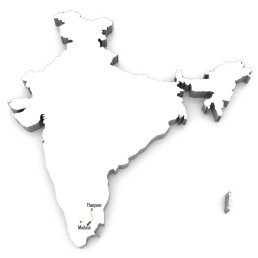
Jnana Yajna 21

Year & Dates:
August 05, 1956 to September 05, 1956

Yajna Topic:
Bhagavad Gita- Chapters 12 & 13

Place:
Madurai, India.
Madurai Railway station was a hub of great excitement on the morning of August 5, 1956, as four thousand devotees waited eagerly for the train arriving from Thanjavur. Seeing Pujya Gurudev Swami Chinmayananda emerge from the compartment was a moment of sheer joy. The temple elephant, ornate and majestic, garlanded him with a joyous trumpeting. Resonant Naada-svara music and percussion accompaniments set the tone for an auspicious beginning.
As thousands chanted the Mahamantra, Pujya Gurudev walked regally behind a decorated car that carried the sacred Ganga Kalashas that would later purify the Yajna audience.
The Field of Love Supreme
The royal welcome indicated how much the Madurai audience was elated about the 31-day Gita Jnana Yajna on chapters 12 and 13. “This is my place, the land of Shiva!” Pujya Gurudev remarked with great love for the legendary Meenakshi-Sundareshwara temple in Madurai. The place was apt for Pujya Gurudev to bring out the profound yoga of devotion in Gita chapter 12. As He explained the attributes of a true devotee, the audience could visualize how a limited ego dissolves in complete identification with the Supreme. In His words, the audience heard the echoes of Saiva Siddhanta, the bhakti-focused literature composed by Tamil saints. He then skillfully spotlighted the essence of Chapter 13 – the way to first distinguish the Kshetra, the inert field of matter and instruments of knowledge, from the enlivening spark of life, the Kshetrajna or Knower. Pujya Gurudev stole the hearts of the large audience in Madurai, personifying an environment of Knowledge sweetened with supreme Love.
In Admiration
The lasting impression of how Pujya Gurudev conducted himself during the talks made an indelible mark on Shri P Chandrasekhar. He wrote: “The punctuality of the Master definitely teaches one that, in religious life, one should be punctual and methodical. The Adhyaksha is so neat and attractive that it removes any misconception that Masters can be shabby and that it has religious sanction. There is military discipline in the Yajna Shala and no interference with it is tolerated.”
Photo Gallery

“Think,” Says Pujya Gurudev
The Path of Devotion is not a mere sentimental explosion or an excessive emotional display. It is not mere frivolous hysteria. It should be a steady inward blossoming of the human personality through discard of all our limitations and acquisition of new vitality during the inspired moments of deep contemplation.
From Bhagavad Gita- Chapters 12 & 13 Book
No wave is all the ocean; all the waves put together are not also the entire ocean. We cannot say the ocean is attached to the waves since the ocean is the very nature of the waves; and though detached, all waves are always supported by none other than the ocean itself. Cotton is in all cloth; cloth is not in cotton. And yet, it is the cotton in the cloth that supports the cloth. Similarly, the world of plurality is not the Consciousness. Yet the Consciousness supports it. Between the ghost and the post, no attachment is ever possible, and yet the post alone is the support of the ghost – as the waking mind alone can support the dreams.
From Bhagavad Gita- Chapters 12 & 13 Book
What is True Devotion?
Jnana Yajna 20
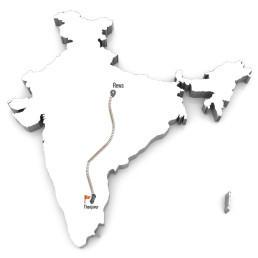
Jnana Yajna 20

Year & Dates:
July 14, 1956 to August 04, 1956

Yajna Topic:
Ishavasya Upanishad

Place:
Thanjavur (Tanjore), India.
Thanjavur’s historic Saraswati Mahal Library, Tamil Nadu, is an acclaimed place of learning and cultural preservation. Its rare palmyra manuscripts, famed collection of medieval books in several indigenous languages, and museum of intricate paintings makes it one of the outstanding libraries in Asia. In such an appropriately eminent place of knowledge, the Upanishad Jnana Yajna of Pujya Gurudev commenced on the sacred Guru Poornima day of July 14, 1956. During that period, the state was gripped by the tension between the orthodox ritualists and the Dravida Kazhagam members who were iconoclasts opposed to Sanatana Dharma. Fearless and fair as Pujya Gurudev was, He welcomed the questioning tendency of the opponents and encouraged the ritualists to strengthen their scriptural knowledge beyond mere practices.
Fearless Power of Satsang
His rational and clear explanations of the declarations of Ishavasya Upanishad every evening for 21 days caught the attention of both these opposing factions and converted many of the skeptics. Pujya Gurudev enthralled the listeners especially with His out-of-the-world meditation sessions every night, during the last half hour of each session. While the supplemental Sadhana such as Akhanda Keertana and the Havana energized the seekers, there were obstacles that arose. Especially on the first three days of August, the Dravida Kazhagam had announced about breaking Sri Rama’s pictures which prompted a statewide curfew. However, Pujya Gurudev’s Upanishad yajna proceeded unhindered. Later, during the procession after their sacred bath, when loud slogans disrupted their keertana, the devotees persisted with their singing to overcome the disturbance. The ardent seekers could stand strong not with negativity but with the firm conviction about the greater goal of life.
In Admiration
Shri Yagnaswami from Tanjore reflects on the insights acquired through the teachings of Gurudev. “I learnt that Bhakti, Jnana and Karma are not distinct limbs of separate Yogas. Bhakti, pure and simple, is the outcome of Jnana. In the first the heart comes into play, in the second Intellect or Jnana enlightens it; the combination of these two is Supreme Love or Prem. My Grhasthaashrama experiences, with all its complications do not now affect me: I remain unattached. Even under extreme provocation, I remain calm and unperturbed due to Guru-Krpa.
Photo Gallery

“Think,” Says Pujya Gurudev
Devotion to a personal God with a form and name is as much important for higher meditation, since continuous and intense meditation upon the formless Reality is necessary for the greater realization of the Self. In this intelligent synthesis of Bhakti and Jnana together the result would be, in the Rishi’s own words, that we will be able to get over the sorrow of death, meaning the sorrows of finitude, because of our faith and devotion to the Lord with a form, while our evolution would be fulfilled completely as a result of our higher meditations upon the formless Reality. A mere meditation upon the Absolute in itself, though it can give a subjective experience of the Self, the Jeevan-Mukta state cannot be peaceful and tranquil without the firm hold on the life-belt of a staunch and unshakable prema for the Lord of the heart.
From Ishavasya Upanishad Book
Which Path Do You Choose?
Embark on a soul-searching journey as Swamiji delves into life’s pivotal question: which path will you choose? Dive into the exploration of contemplation, meditation, or the selfless path of action (Karma Yoga). Gain profound insights into the significance of each choice and the impact it can have on your life’s purpose. Join us in this enlightening discussion and discover the transformative power of your chosen path.
